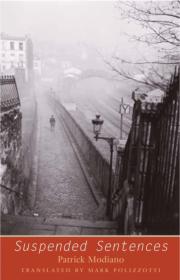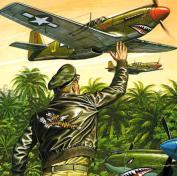|
The memory of a memory
-- the old conundrum.
Sometimes the
narrative refocuses to the adult Patoche. Towards the end he accidentally
encounters Vincent now driving a Jaguar and accompanied by another young silent
woman. Patoche is now a struggling apprentice writer in an unheated dump
somewhere in Paris. It's a difficult reunion, as Patoche knows from the
newspapers that Vincent spent some time in prison for some sort of larceny.
After they part, Patoche finds 2000 francs on his table. Remission worthy?
Could be, although the "good" in the Rue du Docteur-Dordain gang is quickly
established simply by how well the two cast-off boys are treated by this
surrogate family. They're de facto orphans, yet they are privileged to live a
children's story-book adventure courtesy of some kindly crooks.
It should be noted
that remission is an article of French law allowing an inmate to have
his sentence reduced if he meets certain conditions. The French publication
title Remise de peine obviously infers a moral clemency for Roger Vincent, Buck
Danny, Annie & her mother and Little Hélène. In his
articulate foreword translator Mark Polizzotti explains the difficulties
presented by a literal translation of the original title; his choice of
'Suspended Sentences' certainly fits the moral of the story and describes
Patrick Modiano's metaphysics exactly.
The title is a pun,
referring both to the criminal back story and the "suspended" style where the
author never cuts-to-the-chase if he can detour into some descriptive sidebar
which may or may not help the reader understand just exactly what's going on.
Perhaps it has appeal for those who love words for words' sake. Perhaps it
supports the atmosphere, shares the love. Perhaps it's simply another way to
tell a story without resorting to sex and violence.
If you need a clear
through-line, you'll be disappointed. There's little or no conflict to drive
the action, just a series of scenes and portraits that happen as they occur to
the narrator. Unlike most literary writers who just change the names and post
their journal as fiction, Modiano admits the memoir, and in typical Gallic
fashion is greeted as avant-garde. Other writers have done it although the
approach has gained momentum in the post-modern era. The political necessity of
hiding in fiction has diminished, and so has the need for 'plot' (unless one is
writing about a conspiracy). Modiano is such a writer. Memory, nostalgia and
fantasy are his weapons... and while he's a damn good writer line-by-line, the
lack of conflict and the disorderly sense of Time in Suspended Sentences will
cause a lot of readers to drop out fairly quickly. No wonder his work has been
largely ignored in North America even though he's been publishing steadily in
France for years.
This evasiveness, this
piling on of place names and people -- what to make of it? Art is the
correction of a neurosis, says Freud. Modiano is a bit like a drunk who has a
story to tell but who can never get to the point as he keeps vanishing into
personalized asides, laced with nostalgia and sentimentality and irrelevant
ghosts. You might marvel at the performance, yet grow impatient with the
indulgence.
That's the brutal
view. For those who persevere, the beauty of the writing might overcome the
voyeur's hunger for forbidden thrills and easy space travel.
§ III...
Flowers of Ruin: here 'I' plays voyeur detective for no real reason
other than geographic curiosity. Once again Modiano writes like a man serving
time in prison who has nowhere to go but meander through his memories,
especially those that form puzzles, hang in the mind like unresolved chords.
People he encountered, then forgot -- surely they were exotic criminals,
impoverished aristocrats, funky artists etc etc?
Once again many will
find the details foreign and frustrating, while others will no doubt luxuriate
in the poetic impressionism. There are some killer lines, mystical
descriptions, and an orchestral atmosphere that borders on pedantic madness.
The passivity of the narrator is anti-dramatic, as he drifts through Time and
Space like a camera, ducking the responsibility that goes with being a bonafide
protagonist. What is he, you wonder -- animal, vegetable or mineral? Well, it's
like he studied some old tour guides to Paris, some news clippings,
cannibalized them, then montaged them into the narrative.
Does Modiano use the
cutup method of textural montage? Who knows... possibly he's a cultural
archaeologist... but a novelist? If you try to reduce the action to the
essentials, isolate the through-line, would Flowers even be a short story? Not
really. Causality is vague, characters are left hanging, and the narrative is
occult; it's as if Modiano fell asleep with his head on a stack of paper, later
awoke to find this perfectly imperfect story printed and ready to go.
It's maddening, these
narratives where asides and transitions are as important -- if not more so --
to Modiano than the actual scenes that pass as action. He's a sadist, you
think, and you must be a masochist for hanging in there. And then, just when
you're ready to jump, he hits you with a character or a scene that makes you
purr like a sedated monkey.
"Behind me, the
jukebox was playing an Italian song. The stench of burned tires floated in the
air. A girl was walking under the leaves of the trees along Boulevard Jourdan.
Her blond bangs, cheek-bones, and green dress were the only note of freshness
on that early August afternoon. Why bother chasing ghosts and trying to solve
insoluble mysteries, when life was there, in all its simplicity, beneath the
sun?"
The characters
fleet... the philosopher in the ratty Shetland pullover... the New Wave
starlet... Pacheco the Peruvian air steward (who might be the former German
collaborator Philip de Bellune, maybe interned at Dachau) (aka Charles Lombard,
waiter)... Jacqueline, the narrator's girlfriend who really has no character at
all... Tony in the plaid shirt, the Danish girl who swears but likes the young
wannabe writer... Claude Bernard, part of the old Rue Lauriston Gang along with
the elusive Pagnon who ends up as a bouncer wearing shades outside a club ("a
sentinel for all Eternity")... Simone, the former secretary of Modiano's father
(probably his mistress)... the once famous goalie... et al. There are enough
editions noir characters to keep you going if you just forget about any
resolution.
And in two of the
stories Modiano inherits a suitcase from one of the characters... having
assigned them to oblivion, the author is the only benefactor. Intriguing. Freud
said, art is... well, you get it.
The narrator is
sitting in the darkened apartment with "Jacqueline of the Avenue Rodin" as it
rains steadily outside. Her old lover (literally old) the Marquis has followed
them back, hammers on the door. She doesn't stir. The Marquis returns to the
street, stands watching the window. "Little by little, that man melted into the
wall."
'I' picks up a stray
dog and he and Jacqueline take a train to Vienna. The dog business might remind
some of the dog in Marcel Carne's 1938 film Port of Shadows. Just a thought;
these post-modern writers do like movies; the 'memory of a memory', you
know.
"Back then, the gates
of Paris were all in vanishing perspective; the city gradually loosened its
grip and faded into barren lots. And one could still believe that adventure lay
right around every street corner...."
Great writer, no
question... but a lousy story teller? You decide. You can get him
here:
Suspended
Sentences at Amazon:
USA
|
Canada
|
UK
|
Australia
|

